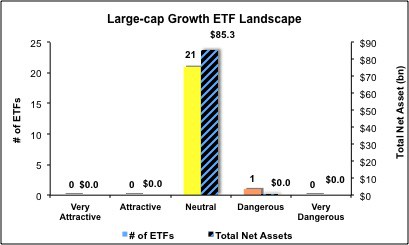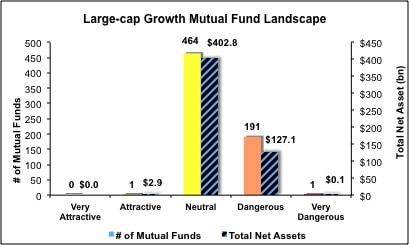The Large Cap Growth style ranks fourth out of the twelve fund styles as detailed in my Style Rankings for ETFs and Mutual Funds report. It gets my Neutral rating, which is based on aggregation of ratings of 22 ETFs and 657 mutual funds in the Large Cap Growth style as of October 17, 2013. Prior reports on the best & worst ETFs and mutual funds in every sector and style are here.
Figures 1 and 2 show the five best and worst-rated ETFs and mutual funds in the style. Not all Large Cap Growth style ETFs and mutual funds are created the same. The number of holdings varies widely (from 19 to 615). This variation creates drastically different investment implications and, therefore, ratings. The best ETFs and mutual funds allocate more value to Attractive-or-better-rated stocks than the worst, which allocate too much value to Neutral-or-worse-rated stocks.
To identify the best and avoid the worst ETFs and mutual funds within the Large Cap Growth style, investors need a predictive rating based on (1) stocks ratings of the holdings and (2) the all-in expenses of each ETF and mutual fund. Investors need not rely on backward-looking ratings. My fund rating methodology is detailed here.
Investors seeking exposure to the Large Cap Growth style should consider buying ASTON/Montag & Caldwell Growth Fund (MCGIX), the only Large Cap Growth ETF or mutual fund that earns an Attractive-or-better rating. Investors seeking more exposure to this style should not buy any other Large Cap Growth ETFs or mutual funds because none get an Attractive-or-better rating. If you must have more exposure to this style, you should buy a basket of Attractive-or-better rated stocks and avoid paying undeserved fund fees. Active management has a long history of not paying off. Here’s the list of our top-rated Large Cap Growth stocks.
Get my ratings on all ETFs and mutual funds in this style by searching for Large Cap Growth on my free mutual fund and ETF screener.
Figure 1: ETFs with the Best & Worst Ratings – Top 5
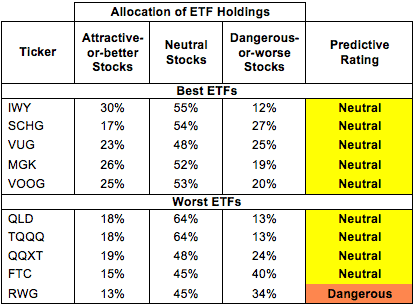 * Best ETFs exclude ETFs with TNAs less than $100 million for inadequate liquidity.
* Best ETFs exclude ETFs with TNAs less than $100 million for inadequate liquidity.
Sources: New Constructs, LLC and company filings
PowerShares RAFI Fundamental Pure Large Growth Portfolio (PXLG) and Columbia Growth Equity Strategy Fund (RPX) are excluded from Figure 1 because their total net assets (TNA) are below $100 million and do not meet our liquidity minimums.
Figure 2: Mutual Funds with the Best & Worst Ratings – Top 5
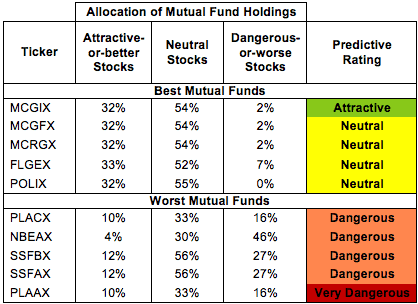 * Best mutual funds exclude funds with TNAs less than $100 million for inadequate liquidity.
* Best mutual funds exclude funds with TNAs less than $100 million for inadequate liquidity.
Sources: New Constructs, LLC and company filings
iShares iShares Russell Top 200 Growth ETF (IWY) is my top-rated Large Cap Growth ETF and Aston Funds: ASTON/Montag & Caldwell Growth Fund (MCGIX) is my top-rated Large Cap Growth mutual fund. IWY earns my Neutral rating and MCGIX earns my Attractive rating.
Columbia Large-Cap Growth Equity Strategy Fund (RWG) is my worst-rated Large Cap Growth ETF and PACE Select Advisors Trust: PACE Large Co Growth Equity Investments (PLAAX) is my worst-rated Large Cap Growth mutual fund. RWG earns my Dangerous rating and PLAAX earns my Very Dangerous rating.
Figure 3 shows that 173 stocks (over 18% of the market value) in Large Cap Growth ETFs and mutual funds get an Attractive-or-better rating. However, no Large Cap Growth ETFs and 1 out of 657 Large Cap Growth mutual funds (less than 1% of total net assets) get an Attractive-or-better rating.
The takeaways are: mutual fund managers allocate too much capital to low-quality stocks and Large Cap Growth ETFs hold poor quality stocks.
Figure 3: Large Cap Growth Style Landscape For ETFs, Mutual Funds & Stocks
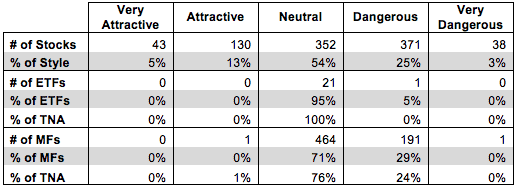 Sources: New Constructs, LLC and company filings
Sources: New Constructs, LLC and company filings
As detailed in “Low-Cost Funds Dupe Investors”, the fund industry offers many cheap funds but very few funds with high-quality stocks, or with what I call good portfolio management.
Investors need to tread carefully when considering Large Cap Growth ETFs and mutual funds, as all but one fund earn Neutral-or-worse ratings. No ETFs and one mutual fund in the Large Cap Growth style allocate enough value to Attractive-or-better-rated stocks to earn an Attractive rating. Investors would be better off to focus on individual stocks instead.
Verizon Communications, Inc. (VZ) is one of my favorite stocks held by Large Cap Growth ETFs and mutual funds and earns my Attractive rating. Verizon has grown after-tax profits (NOPAT) by 12% compounded annually over the past 15 years. The company has also generated positive and growing economic earnings in each of the last five years. While Verizon has a strong track record of growth and profitability, VZ trades at ~$47/share, giving it a price-to-economic book value (PEBV) of 1.03. This valuation implies that the market expects Verizon’s NOPAT to increase by only 3% compounded annually over the remainder of the company’s existence. Having grown NOPAT by 12% compounded annually for well over a decade, these expectations for Verizon’s growth seem too pessimistic. A strong growth track record and low expectations give VZ an attractive risk/reward profile.
Pioneer Natural Resources Company (PXD) is one of my least favorite stocks held by Large Cap Growth ETFs and mutual funds and earns my Dangerous rating. Pioneer has only grown after-tax profits (NOPAT) by 3% compounded annually over the past decade. The company generates a return on invested capital (ROIC) of only 4%, which puts it in the bottom quintile of all of the companies that I cover. Pioneer has also failed to generate any positive economic earnings in the last 15 years. Despite this poor cash flow track record, the stock is very expensive. To justify PXD’s current price of ~$212/share, the company would have to grow NOPAT by 31% compounded annually over the next 14 years. For a company with a history of poor profitability, these expectations seem unrealistic. Poor cash flow and expensive stock valuation mean investors should steer clear.
Figures 4 and 5 show the rating landscape of all Large Cap Growth ETFs and mutual funds.
My Style Rankings for ETFs and Mutual Funds report ranks all styles and highlights those that offer the best investments.
Figure 4: Separating the Best ETFs From the Worst Funds
Figure 5: Separating the Best Mutual Funds From the Worst Funds
Review my full list of ratings and rankings along with reports on all 22 ETFs and 657 mutual funds in the Large Cap Growth style.
Jared Melnyk contributed to this report.
Disclosure: David Trainer and Jared Melnyk receive no compensation to write about any specific stock, sector, style or theme.

